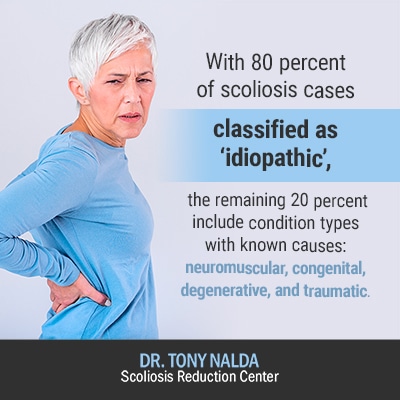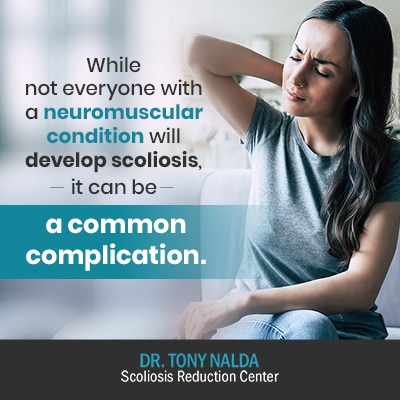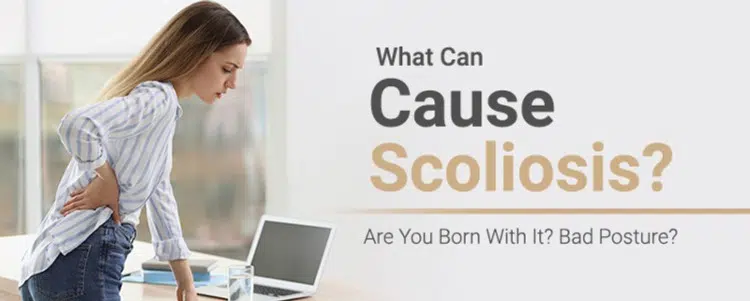Part of the reason scoliosis is so often described as ‘complex and mysterious’ is because there is a wide range of condition severity, its causation is not fully understood, and there are different condition types that can develop. The vast majority of scoliosis cases are classified as ‘idiopathic’, meaning not associated with a single-known cause. People who are born with the condition have congenital scoliosis, and bad posture cannot cause scoliosis because it is a structural condition.
There are different types of scoliosis, some with unknown causes and some with known causes. With 80 percent of diagnosed cases being idiopathic, causation is largely unknown. The remaining 20 percent are condition forms with known causes: neuromuscular, congenital, degenerative, and traumatic.
To start our discussion of what causes scoliosis, let’s first explore the parameters that have to be met to reach a scoliosis diagnosis.
What is Scoliosis?
The spine is naturally curved for several important reasons: it gives it added strength, flexibility, and helps it to evenly distribute stress that’s incurred during movement.
There are a number of spinal conditions people can develop that involve a loss of the spine’s healthy and natural curvatures. As an unnatural curve develops, it affects the entire spine as it disrupts its biomechanics and can cause it to become misaligned.
Scoliosis is an abnormal sideways curvature of the spine, and in order for a scoliosis diagnosis to be given, the curvature has to include rotation and be of a minimum size.
Known as the gold standard for diagnosing and assessing scoliosis, ‘Cobb angle’ is an important measurement that tells me how far out of alignment a scoliotic spine has become, and this measurement places a condition on its severity scale of mild, moderate, severe, or very severe:
- Mild scoliosis: Cobb angle measurement of between 10 and 25 degrees
- Moderate scoliosis: Cobb angle measurement of between 25 and 40 degrees
- Severe scoliosis: Cobb angle measurement of 40+ degrees
- Very-severe scoliosis: Cobb angle measurement of 80+ degrees
A patient’s Cobb angle is measured during X-ray by drawing lines from the tops and bottoms of the curvature’s most-tilted vertebrae at the apex of the curve; this will involve multiple vertebrae. The intersecting lines form an angle that’s measured in degrees.
In order for a scoliosis diagnosis to be given, an abnormal sideways curvature has to include rotation, making it a 3-dimensional condition, and have a minimum Cobb angle measurement of 10 degrees.
So now that we know the requirements that have to be met to reach a scoliosis diagnosis, let’s move on to the different types of scoliosis and their causes.
As 80 percent of diagnosed cases are idiopathic, this is the condition’s most prevalent type, which is where we’ll start.
Idiopathic Scoliosis
As mentioned, ‘idiopathic’ means that a condition has no known cause, that its causation can’t clearly be tied to one single-known cause; however, this doesn’t mean there is a complete absence of cause as a condition can have multiple causes, as is the case with idiopathic scoliosis.
Idiopathic scoliosis is, instead, considered to be multifactorial, meaning its development is caused by multiple factors that can vary from one person to the next.
The most prevalent form of scoliosis is adolescent idiopathic scoliosis (AIS), diagnosed between the ages of 10 and 18, and while we know its progression is connected to growth, we don’t fully understand why adolescent idiopathic scoliosis develops initially.
While idiopathic scoliosis is more commonly diagnosed during adolescence, it can also affect adults, and is, in fact, the most common form of adult scoliosis; this is because many cases of AIS, particularly mild ones, produce subtle signs and symptoms that can go unnoticed for years.
It’s not uncommon for AIS to remain undiagnosed and untreated during adolescence, and it’s not until patients reach skeletal maturity in adulthood that the condition starts to produce more noticeable symptoms such as postural changes and pain.
Pain is the big divider when it comes to the main difference between living with scoliosis as a child/adolescent, or as an adult.
For children and adolescents who have not yet reached skeletal maturity, because they are still growing, their spines are exposed to a constant lengthening motion, and this can counteract the abnormal spinal curvature’s compression of the spine and its surrounding muscles and nerves.
In adults whose spines have settled due to gravity and maturity, there is nowhere for that compressive force to go, which can cause varying levels of pain felt in the back, muscles, and when nerve compression occurs, radiating pain felt in the legs and feet.
The majority of my adult patients come to see me because they are feeling scoliosis-related pain throughout their bodies. If they are noticing postural changes, this often involves a prominent lean to one side.
So there is no single-known cause for idiopathic scoliosis, and as we touched on how idiopathic scoliosis is also the most common type affecting adults, let’s move on to discussing other forms of the condition that are associated with known causes.
Scoliosis with Known Causes

With 80 percent of scoliosis cases classified as ‘idiopathic’, the remaining 20 percent include condition types with known causes: neuromuscular, congenital, degenerative, and traumatic.
Causation is important because it’s a condition’s underlying cause that drives the design of effective treatment plans.
When it comes to scoliosis, this is particularly important as the condition is progressive, meaning it’s in its nature to worsen over time, and treatment has to be proactive in order to counteract the curvature’s natural tendency to increase in size.
As neuromuscular scoliosis is one of the most challenging types to treat, let’s start there.
Neuromuscular Scoliosis
My neuromuscular scoliosis (NMS) patients are among the most challenging to treat because their scoliosis develops as a secondary complication of a larger neurological condition.
While not everyone with a neuromuscular condition will develop scoliosis, it can be a common complication.
There are numerous neurological conditions and diseases that can lead to the development of NMS such as muscular dystrophy, cerebral palsy, myelodysplasia, and many more.
I say that this type of scoliosis is difficult to treat because the neurological condition is its underlying cause and needs to drive the treatment approach, and this can complicate the treatment process, in comparison with more typical forms of the condition.
So the cause of neuromuscular scoliosis is an underlying neurological condition that affects the muscles and/or the connective tissues that help support and stabilize the spine.
Congenital Scoliosis
Congenital scoliosis is a rare form that affects approximately 1 in 10,000. Infants are born with congenital scoliosis as it develops in utero due to a malformation in the vertebrae (bones of the spine).
Malformations can involve extra segments of bone, or vertebrae failing to form into separate and distinct bones and becoming fused together.
So can you be born with scoliosis, or does it develop? The answer to this common query will depend on the type of scoliosis in question. In cases of congenital scoliosis, yes, you can be born with it, but with other forms, it can develop over time, or be caused by a spinal trauma or injury.
Degenerative Scoliosis
As discussed, idiopathic scoliosis is the most common type in adults, as continuations of adolescent idiopathic scoliosis, and the next most prevalent form of adult scoliosis is degenerative.
Degenerative scoliosis most commonly affects people over the age of 40 and can develop slowly over time as the spine experiences degenerative changes.
The body naturally degenerates with age, and this includes the spine. Most commonly, it’s the spine’s intervertebral discs that start to deteriorate.
In a healthy spine, its vertebrae are stacked on top of one another in a straight and healthy alignment, but for a spine facing deterioration, it can be difficult to maintain its healthy curvatures and alignment.
The intervertebral discs sit between adjacent vertebrae to provide the spine with cushioning, structure, vertebral flexibility, and act as shock absorbers so stress is evenly distributed throughout the spine.
If the discs start to deteriorate, they can become dehydrated and lose height, and this can cause a shift in the spine’s position and lead to it becoming misaligned and developing degenerative scoliosis.
The presence of additional spinal conditions like osteoporosis, which decreases bone mass, can exacerbate spinal deterioration and lead to injuries such as fractures, that can also cause the development of degenerative scoliosis.
In addition, the cumulative effect of certain lifestyle choices can also increase spinal deterioration: obesity, a sedentary lifestyle, chronic bad posture, and repeatedly lifting heavy objects incorrectly and straining the spine.
Traumatic Scoliosis
In cases of traumatic scoliosis, as the name indicates, this is caused by some type of trauma experienced by the spine, such as a car accident or fall.
In addition, tumors pressing on the spine can also lead to the development of traumatic scoliosis as the spine is pushed out of alignment, and treatment for tumors, such as chemotherapy and radiation, can also weaken the spine, making it that much more vulnerable to trauma and injury.
So now that we have talked about the main form of scoliosis as idiopathic, as well as the condition types with known causes, I’d like to answer a common question by addressing whether or not bad posture has been identified as a causative source for scoliosis.
Can Scoliosis Be Caused by Bad Posture?

Many people assume that scoliosis can be caused by bad posture, but bad posture has not been identified as a potential cause.
Conditions caused by bad posture are temporary, often alleviated or eliminated when body position is changed or improved upon through movement, stretches, and exercise; when a condition is structural, like scoliosis, it is a permanent issue where the spine itself is in need of treatment that impacts it on a structural level.
Scoliosis-specific chiropractic care is a huge component of my treatment approach here at the Scoliosis Reduction Center® because it can do just that: impact the condition on a structural level in the form of a curvature reduction achieved through chiropractic adjustments combined with other scoliosis-specific treatment disciplines.
Even in cases of ‘functional scoliosis’, which differs from a true structural scoliosis as there are no structural abnormalities within the spine, or rotation, bad posture is not considered a common cause. Functional scoliosis is more clearly connected to an irregularity found elsewhere in the body such as leg length discrepancy (LLD).
As scoliosis involves structural abnormalities within the vertebrae of the spine, chronic bad posture, although not good for overall spinal health and biomechanics, does not have the power to cause a structural change within the spine itself.
While bad posture isn’t associated with scoliosis causation, it can be bad in a lot of other ways. Chronic bad posture has been linked to back, neck, shoulder, and arm pain, as well as the development of another common spinal condition: hyperkyphosis.
So can bad posture cause scoliosis? No, it can’t ‘cause’ scoliosis, but bad posture can lead to a host of other problems, including speeding up spinal degeneration, and should be addressed in the interest of overall spinal health and function.
Another common question I’m asked is, “Can scoliosis happen suddenly?”
Can Scoliosis Happen Suddenly?
When people are diagnosed with scoliosis, they naturally have a lot of questions, which is why I’ve spent time addressing some of these common questions.
Many people want to know if scoliosis can happen suddenly. In the majority of scoliosis types that we have discussed, scoliosis development occurs over time.
Often, there is a large gap between when a condition first developed and when it was first diagnosed, so people can assume it happened suddenly, close to the time of diagnosis, but that’s not a common scenario; this is especially true in cases of adolescent idiopathic scoliosis where rapid-phase progression occurs due to rapid and unpredictable growth spurts.
So while a condition can progress suddenly, commonly caused by a big growth spurt, it’s more accurate to say that scoliosis develops over time, with the exception of some cases of traumatic scoliosis where a sudden spinal trauma or injury causes the development of a scoliotic curve.
Conclusion
For those asking what can cause scoliosis, the answer will depend on the condition type in question. In the vast majority of cases (80 percent), cause is unknown and conditions are classified as ‘idiopathic’.
‘Idiopathic’ means there is no single-known cause, but this does not mean there is a complete absence of a cause; it simply means that the condition is likely caused by multiple variables (multifactorial) that can vary from one person to the next.
The most prevalent type of scoliosis is adolescent idiopathic scoliosis (AIS), and the most common form to affect adults is a continuation of AIS that is simply not diagnosed, nor treated, until reaching adulthood; at this time, skeletal maturity has been reached, and the condition tends to produce more noticeable symptoms such as pain (more common in adults) and postural changes.
After idiopathic scoliosis in adults, degenerative scoliosis is the next most common type affecting adults, and this is caused by deterioration of the spine, commonly its intervertebral discs, which can occur slowly over time.
When it comes to the 20 percent of scoliosis types with known causes, we are talking about degenerative, neuromuscular, congenital, and traumatic scoliosis.
In neuromuscular scoliosis, we know its cause is related to a larger neuromuscular condition that complicates the treatment process because the underlying cause is neuromuscular, and this has to be the guiding force of treatment plans.
In cases of congenital scoliosis, infants are born with the condition as it develops in utero, and we know that this type is caused by malformations within the spine itself, such as misshapen vertebrae, or vertebrae that fail to form into separate bones and become fused together.
In traumatic scoliosis, causation is the result of a trauma experienced by the spine. Injuries from falls, car accidents, and/or spinal fractures related to other spinal conditions can also be the cause. In addition, the presence of tumors pressing on the spine can also lead to the development of traumatic scoliosis.
Each different type of scoliosis has its own unique treatment needs driven by the condition’s underlying cause (when known) and/or important patient and condition characteristics such as age, condition severity, and curvature location.
Here at the Scoliosis Reduction Center®, I have treated a wide range of scoliosis types, severity levels, and patients of all ages. While I might not know the cause of every form, such as idiopathic, I most certainly know how to respond once the condition is diagnosed: with proactive treatment that works towards impacting the condition on a structural level and providing the spine with better support and stabilization.





